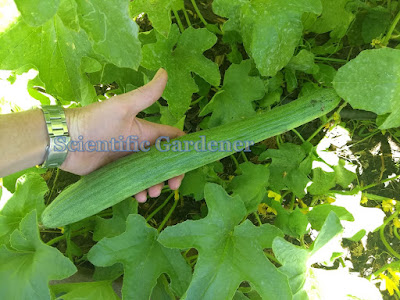Usually I have the opportunity to grow one or two crops of cucumber-melon in each garden I work in. Last year, I made an attempt to grow out the Long Dark Armenian cucumber. I’m probably the exception, but it seems that every summer I am always trying to get one more crop in before summer is over. This last year was no exception. Before starting back at my work, I sprouted my cucumbers, then put them in 2 inch soil blocks, followed by 4 inch soil blocks.
 |
| In Italian, this is the Tortarello Barese Verde (Scuro) |
I had to go on a trip and didn’t want to worry about the 4” blocks, so I just put a drip line over the 4” blocks and put wood boards on either side to ensure that they would receive ample water each day. The bottom of each block was also on a wood board, so I could just take them out of the garden and transplant them to my work garden.
The plot I was working with had not been used for at least several years. Previously it was mostly weeds.
By the time I was able to transplant the cucumbers, the vines were pretty overgrown for the size of the soil blocks.
Something about the transplanting process didn’t go so smoothly and the local aphids took note. Soon a large colony of aphids was congregating on my cucumber plants.
It wasn’t until I grew out this generation of dark Armenian cucumbers that I realized that, like other cucumber-melons, the dark Armenian cucumber is also photosensitive. Many of the cucumbers that were under shade were relatively light, while those that were exposed to more direct sunlight developed much darker rinds.
I really enjoyed the opportunity to share some of my fresh cucumber varieties with colleagues. Most of them really enjoyed this cucumber variety. It seems that many people appreciate crispy crunchy cucumbers more than tender, yet crisp high-quality cucumbers.
Eventually, the cucumber plants began to succumb to powdery mildew. I believe that one day I will be able to find a better remedy for powdery mildew than diluted milk, baking powder or just pulling letting it run its course. I have tried many of the home remedies without any success.
Near the end of the season, the plants finally produced a really long female flower, but alas the plant was so stressed that the fruit was not able to fully develop.
Of all my longer cucumber varieties, the dark Armenian is one of my favorite. Hopefully I can get another few long cucumbers next time so that I can select for future generations of Long Dark Armenian cucumbers.




























































































